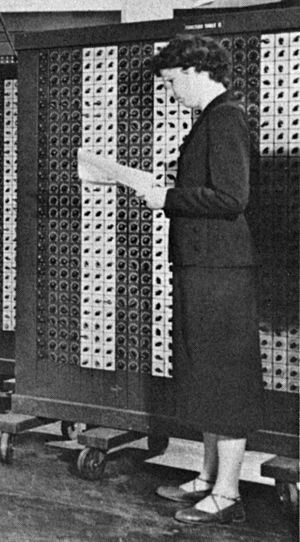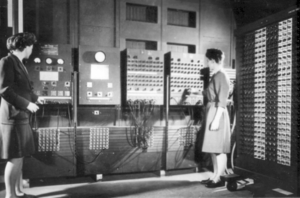Betty Holberton facts for kids
Quick facts for kids
Betty Holberton
|
|
|---|---|
 |
|
| Born |
Frances Elizabeth Snyder
March 7, 1917 |
| Died | December 8, 2001 (aged 84) |
| Education | University of Pennsylvania |
| Occupation | Computer scientist |
| Employer | Moore School of Engineering University of Pennsylvania Remington Rand National Bureau of Standards David Taylor Model Basin |
| Known for | ENIAC |
| Spouse(s) | John Vaughan Holberton |
| Children | Priscilla Holberton Pamela Holberton |
| Awards | Women in Technology International Hall of Fame |
Frances Elizabeth Holberton (born March 7, 1917 – died December 8, 2001) was an American computer scientist. She was one of the first six people to program the ENIAC. The ENIAC was the very first general-purpose electronic digital computer.
The other five ENIAC programmers were Jean Bartik, Ruth Teitelbaum, Kathleen Antonelli, Marlyn Meltzer, and Frances Spence. Betty Holberton also invented "breakpoints" in computer debugging. This is a way to pause a program to find errors.
Contents
Early Life and Education
Frances Elizabeth Snyder was born in Philadelphia, Pennsylvania in 1917. She was the third of eight children.
Holberton chose to study journalism at the University of Pennsylvania. This field allowed her to explore many different subjects. In the 1940s, journalism was one of the few careers open to women. On her first day, her math professor suggested she might be better off at home. But Betty Holberton proved him wrong with her amazing work in computing.
Career as a Computer Pioneer
During World War II, the Army needed to calculate the paths of artillery shells. Many women were hired for this important job. Betty Holberton was hired by the Moore School of Engineering. She was chosen to be one of the six women who would program the ENIAC.
The ENIAC stood for Electronic Numerical Integrator And Computer. These women were called "subprofessionals." Holberton, along with Kay McNulty, Marlyn Wescoff, Ruth Lichterman, Betty Jean Jennings, and Fran Bilas, programmed the ENIAC. They made it perform calculations for the Ballistic Research Laboratory (BRL) of the US Army.

At first, the ENIAC was a secret project. The programmers could only work with blueprints and wiring diagrams. They used these to understand how to program the huge machine. Betty Holberton had many great ideas, even in her sleep! Other programmers joked that she "solved more problems in her sleep than other people did awake."
The ENIAC was shown to the public on February 15, 1946. This happened at the University of Pennsylvania. It cost about $487,000, which was a lot of money back then.
After the ENIAC
After World War II, Holberton continued her work in computing. She worked at Remington Rand and the National Bureau of Standards. In 1959, she became the Chief of the Programming Research Branch. This was at the Applied Mathematics Laboratory at the David Taylor Model Basin.
She helped develop the UNIVAC computer. She designed control panels that made it easier to use. For example, she put the number pad right next to the keyboard. She also convinced engineers to change the UNIVAC's color from black to a gray-beige. This color became very common for computers.
Betty Holberton also helped create the first "generative programming system." This system was called SORT/MERGE. She used a deck of playing cards to figure out how to sort data. She wrote code that used ten tape drives to read and write data. She also wrote the first program for statistical analysis. This program was used for the 1950 US Census.
In 1953, she became a supervisor of advanced programming. This was in a Navy lab in Maryland. She stayed there until 1966. Holberton worked with John Mauchly to create the C-10 instruction set for BINAC. This is seen as an early version of modern programming languages. She also helped develop early standards for the COBOL and FORTRAN programming languages. She worked with another famous computer scientist, Grace Hopper. Later, she helped revise the Fortran language standard.
Awards and Recognition
Betty Holberton received many awards for her pioneering work.
- In 1997, she received the Augusta Ada Lovelace Award. This is the highest award given by the Association for Women in Computing. She was the only woman from the original ENIAC team to receive it.
- Also in 1997, she received the IEEE Computer Pioneer Award. This award recognized her for developing the sort-merge generator. This invention "inspired the first ideas about compilation" in computer programming.
- In the same year, she was inducted into the Women in Technology International WITI Hall of Fame. She was honored along with the other original ENIAC programmers.
Legacy
Betty Holberton's work continues to inspire people today.
- The Holberton School, a school for software engineers, was founded in her honor in 2015. It is located in San Francisco.
- In 2010, a documentary called "Top Secret Rosies: The Female "Computers" of WWII" was released. This film featured interviews with three of the six women who programmed the ENIAC. It highlighted their important contributions during World War II.
- The ENIAC team also inspired the award-winning 2013 documentary The Computers. This film includes old footage of the ENIAC team. It also has interviews with the women as they remember their time working on the ENIAC. This documentary is the first in a series. The others are called The Coders and The Future-Maker.
Death
Betty Holberton passed away on December 8, 2001, in Rockville, Maryland. She was 84 years old. She was survived by her husband, John Vaughn Holberton, and her daughters, Pamela and Priscilla.
Images for kids
See also
 In Spanish: Betty Snyder Holberton para niños
In Spanish: Betty Snyder Holberton para niños


